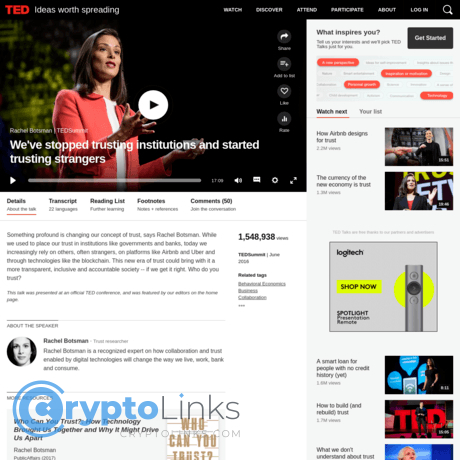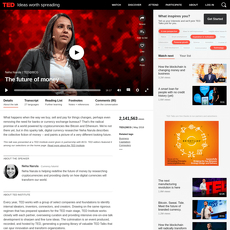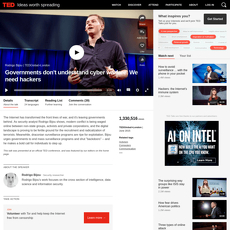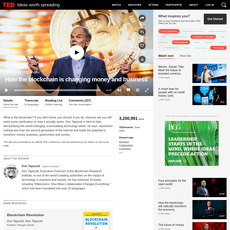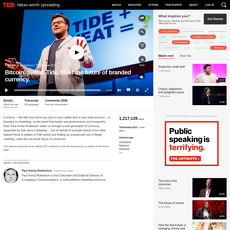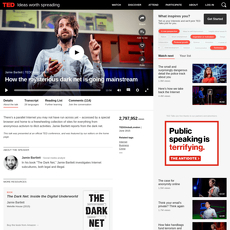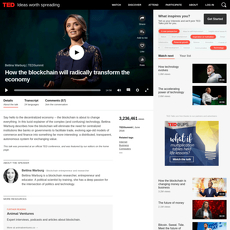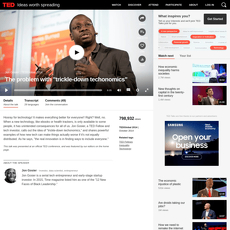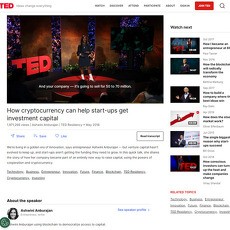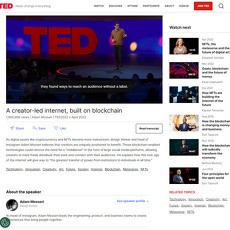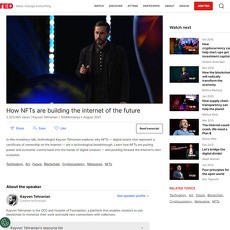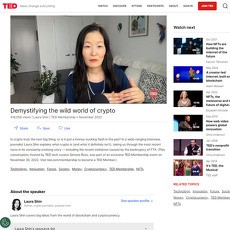Rachel Botsman: We've stopped trusting institutions and started trusting strangers Review
Rachel Botsman: We've stopped trusting institutions and started trusting strangers
www.ted.com
We Stopped Trusting Institutions and Started Trusting Strangers: My Review of Rachel Botsman’s TED Talk (and What It Means for Crypto) + FAQ
Have you ever trusted a stranger with a wallet address or an app review more than your bank, your exchange, or a regulator? Same. And it’s not because we’ve all lost our minds—it’s because the rules of trust have changed. Rachel Botsman explains the shift clearly in her TED talk, and it’s a lens I use every day to decide which crypto products deserve a spot on my screen and which ones go straight to the bin.
In this guide, I break down her ideas in plain English, connect them to real crypto decisions, and give you a practical checklist to cut through hype. If you’ve been burned (or just want to avoid the burn), keep reading.
“We’ve stopped trusting institutions and started trusting strangers.” — Rachel Botsman
The trust problem we’re all feeling
Crypto promised self-sovereignty and open systems. We got that—and we also got a wave of shiny promises that didn’t hold up. The result? Confusion and justified skepticism. A few reminders from the last few years:
- Exchange blowups: FTX collapsed and its founder was convicted of fraud—hard proof that brand, marketing, and stadium names aren’t controls (DOJ).
- “Safer yield” mirages: Centralized lenders promised stable returns until they didn’t (Celsius, BlockFi). When the tide went out, custody, risk, and governance were anything but transparent.
- Token and rating games: Paid promos and gamed metrics misled retail—Kim Kardashian even paid a penalty over a token endorsement (SEC).
- Opaque “decentralization”: Protocols marketed as community-run sometimes turned out to be controlled by a few admin keys or a small multisig.
This isn’t just a crypto issue. Trust in major institutions has been wobbling for years. The Edelman Trust Barometer shows persistent skepticism toward government and media, while people increasingly rely on peers, networks, and platforms to make important decisions. In crypto, that shift is extreme: we now rely on code, wallets, audits, on-chain data, and strangers’ reputations to move money and identity around the world.
Here’s the pain in one line: who do you trust with your money, data, and keys when the old gatekeepers aren’t reliable and the new ones might be unproven?
What this guide promises
I’m going to:
- Explain Botsman’s key ideas about how trust moves and how we take “trust leaps.”
- Show how that maps to crypto—where belief shifts from institutions to networks, code, and verifiable proof.
- Give you a simple checklist to judge projects, platforms, and people—so you can ask for evidence instead of slogans.
- Answer quick questions and point you to tools and resources I actually use.
You’ll walk away knowing how to spot strong trust signals, filter out noise, and avoid the classic traps: fake transparency, gamed ratings, and cults of personality.
Why listen to Rachel Botsman (and why I’m covering this on Cryptolinks)
Botsman is one of the clearest voices on how platforms and technology reshape trust. Her TED talk has been watched by millions, and her book “Who Can You Trust?” maps the shift from institutional trust to distributed trust with stories and research that actually hold up.
What she says mirrors what I see daily in crypto: trust is moving from big brands to systems that make behavior legible—on-chain history, attestations, audits, and social reputation. After FTX, I tightened how I review products: no liability-matching proof of reserves? Hard pass. “Decentralized” but controlled by a 2-of-3 multisig? That’s not decentralization—it’s a single point of failure with extra steps. This lens consistently helps separate real builders from clever marketers.
And yes, the data backs the caution. Crypto crime and scams still cost users billions each year, even as on-chain analytics improve (Chainalysis Crypto Crime Reports). The answer isn’t to give up; it’s to upgrade how we judge trust.
Who this is for and what you’ll learn
If you invest, trade, build, or just explore Web3 tools, this guide will help you:
- Map trust flows in a product: who holds power, who can break things, who is accountable.
- Read signals vs. noise: real audits vs. logo walls, real-time proof vs. PDFs, user control vs. marketing spin.
- Demand proof over promises: on-chain metrics, liability-matching PoR, verifiable governance, and incident history.
- Avoid traps: fake transparency, pay-to-play ratings, influencer-driven tokenomics, “too big to fail” narratives.
If you’ve ever wondered whether to trust a glossy exchange, a new DeFi protocol, or a “stable” stablecoin, you’re in the right place. I’ll make the questions simple—and the red flags impossible to miss.
Ready to see the shift Botsman is talking about—and how it explains the mess (and promise) we’re living through? Up next, I’ll break down the core idea: the trust shift from institutions to networks, and why it changes how you move money online. Want the one line that ties Airbnb, smart contracts, and your hardware wallet together?
The talk in a nutshell: the trust shift
Rachel Botsman’s big idea is simple and feels uncomfortably true: trust moved from local (the baker you knew) to institutional (banks, regulators, media), and now to distributed systems where strangers, algorithms, and platforms carry the weight. That’s why you’ll book a stranger’s spare room with five stars and hesitate when a glossy institution asks you to “just trust us.”
It isn’t just a vibe. Independent research keeps showing a long slide in confidence in traditional gatekeepers, while people put more weight on transparent systems and peer signals. If you’re in crypto, you’re living this shift daily—verifying balances on-chain, reading audits, scanning reputations, and letting a wallet, not a bank branch, be the center of your financial life.
“We’ve stopped trusting institutions and started trusting strangers.” — Rachel Botsman
To me, that line lands because it explains why on-chain proofs, open-source code, and public reputation can feel safer than a polished brand. We haven’t lost the need for trust—we’ve changed who earns it and how.
“We stopped trusting institutions and started trusting strangers”
Online, this shift shows up in thousands of tiny decisions. We replace promises from big names with signals we can check:
- Ratings and reviews: Airbnb, Uber, and eBay normalized trusting high-scoring strangers over low-clarity institutions. In crypto, peer scores show up as GitHub activity, past governance votes, and contributor histories.
- Wallets and smart contracts: A wallet address with an ENS name, a history you can scan on Etherscan, and a contract verified on-chain is often more trustworthy than an off-chain promise.
- Social proof and identity breadcrumbs: Public commits, signed messages, Gitcoin Passport stamps, credible followers, and consistent communication beat faceless PR.
- Escrow and programmatic guarantees: Multisigs, timelocks, and audited contracts reduce the need to trust a person at all—you trust the rules.
We still trust people—we just want that trust wired into systems that make behavior visible and costly to fake.
Trust leaps: how we cross scary gaps
Botsman calls the scary moment between “no way” and “why not?” a trust leap. The first time you stayed in a stranger’s home, it was a leap. The first time you sent USDC into a DeFi contract, same thing. Good products shrink that gap with clarity, guarantees, and verifiable proof.
Here’s what actually reduces the leap in crypto:
- Clear, legible risk: Wallets like Rabby simulate transactions and show exactly what you’re signing. EIP-712 typed messages make permissions readable instead of mysterious hex.
- Programmatic safety: Timelocked upgrades, multisig thresholds, and battle-tested libraries (e.g., OpenZeppelin Contracts) reduce “gotchas.”
- Proof over promises: Exchanges that publish Merkle-tree proof-of-reserves with matching liabilities make the leap smaller than those with slick ads and no math.
- Reputation you can actually check: Public post-mortems, bug bounties listed on Immunefi, and an audit trail from firms like Trail of Bits create a breadcrumb path of accountability.
When a product respects your fear and answers it with specifics—screens you can understand, controls you can verify—that’s when adoption happens.
Platforms as the new trust brokers
If institutions used to be our referees, platforms are now the group chat admins of the economy. Their design choices decide whose behavior is legible and whose isn’t.
- Reputation rails: Reviews and dispute systems built Airbnb and Uber. On-chain, those rails are Dune dashboards, DeFi Llama metrics, contract verifications, governance forums, and explorer labels that flag risk.
- Matching engines: AMMs, lending algorithms, or NFT marketplaces aren’t just markets—they’re trust brokers deciding which counterparties meet and on what terms.
- Risk signaling: Visible insurance funds, safety modules (like Aave’s), and public incident histories earn compounding trust. Hidden blowups don’t.
One important reality check: new brokers are new choke points. Stablecoin issuers, bridges, indexers, or a single sequencer can become gatekeepers. The platform that makes trust visible also controls what we get to see—so the question is always: who controls the settings?
Money vs trust: different currencies
Botsman draws a line I come back to when I see “too-good-to-be-true” APYs plastered on a homepage:
Money moves transactions. Trust moves interactions.
Paying yield doesn’t buy trust. We watched high-paying platforms implode—Celsius, Terra’s “risk-free” 20%, and a certain exchange that looked invincible until basic proofs were missing. The lesson is boring and powerful: trust compounds from repeated right actions and visible constraints, not marketing budgets.
- Trust earners: Protocols that ship audits on a cadence, publish on-chain health metrics, and let you exit without drama. Stablecoins with frequent, independent attestations and predictable redemptions.
- Trust burners: Opaque ownership, celebrity endorsements instead of proofs, flaky withdrawal policies, and “we’re too big to fail” messaging.
In crypto, the strongest currency is still confidence that rules will hold when it hurts—not an eye-popping APY banner.
You can feel the shift. The question is how to turn these ideas into something you can check in minutes—so you can say yes to the right strangers and no to the wrong hype. Want a simple way to do that next time you size up a token, exchange, or wallet? Keep going; I break it into a practical checklist you can run on anything you use today.
Key ideas you should know (and how they map to crypto)
“Trust is a confident relationship with the unknown.” — Rachel Botsman
I keep that line in my notes because it’s the exact feeling you get when you click “Deposit,” sign a transaction, or mint an NFT. You’re stepping into uncertainty. The difference between a good step and a gut-wrenching one comes down to a handful of design choices. Here are the ideas that matter, and how I translate them into things I can actually check in crypto.
Integrity beats rules
Compliance is a checkbox. Integrity is a habit. When a platform earns trust, it’s not because a regulator told them to. It’s because they consistently do the right thing, especially when it hurts.
- Proof over press releases: Exchanges that publish ongoing, user-verifiable proof-of-reserves (not just a one-off PDF) show integrity in action. Bonus points when they explain their methodology in plain English and let you verify your own account’s inclusion.
- Own your mistakes: Compound’s 2021 incident (a bug that overpaid COMP) turned into a masterclass in showing up publicly, explaining what happened, and pushing fixes fast. That kind of transparency creates long-term trust.
- Make users whole when possible: After “Black Thursday” in 2020, Maker governance ran a process to discuss compensation for affected users on the Maker Forum. They didn’t hide. They debated, documented, and acted.
- Stand behind your values: Quarterly transparency reports (e.g., Coinbase) and open-source codebases you can actually inspect are integrity signals that outlast hype cycles.
If I can’t see the pattern—show up, tell the truth, fix the thing—I don’t care what licenses or influencers they wave around.
Transparency is not the same as trust
Dumping data on users is easy. Building understandable, verifiable transparency is hard. And that’s the only kind that moves the needle.
- Make it verifiable: Merkle-tree snapshots without liabilities are half-truths. Real transparency pairs assets and liabilities, explains assumptions, and lets users verify their inclusion. Nic Carter’s work on PoR set a helpful bar; Chainlink’s Proof of Reserves oracles show how automated attestations can reinforce it.
- Make it legible: If users can’t parse it, it’s theater. Research on the “transparency paradox” shows more visibility can reduce trust when people don’t understand what they’re seeing (Harvard Business Review: The Transparency Trap).
- Make it continuous: Trust decays. I look for real-time or frequent attestations, not stale PDFs that quietly disappear when the market gets choppy.
Bottom line: don’t give me a data dump—give me a truth I can check.
Technology enables new trust, but doesn’t guarantee it
Blockchains reduce the need to trust middlemen, but new choke points pop up. Ask the simple question: who can say “no” here?
- Bridges and validator sets: The Ronin hack happened because a small validator set was compromised. Technology didn’t fail—governance and concentration did.
- Stablecoin switches: USDC has frozen addresses to comply with sanctions (Circle’s statement). That may be necessary from a compliance lens, but it’s a reminder: issuer policy is a trust layer.
- RPC and infra: When Infura hiccups, most wallets hiccup. Redundancy and client diversity aren’t “nice-to-haves”—they’re part of your trust surface.
Tech shifts the trust map; it doesn’t erase it. I trace where power concentrates and how it’s checked—on-chain and off.
Data and ownership matter
We spent a decade trading our data for convenience. Web3 promises a swap: you hold the keys; you choose what to reveal. That’s only real if the defaults and UX don’t sell you out.
- Keys with training wheels: The EIP-4337 account abstraction pattern enables social recovery and spending limits—usable security that doesn’t shove seed phrases into a sticky note. This is what progress looks like.
- Beware “features” that weaken control: The Ledger Recover backlash wasn’t just drama; it was a red flag about communication and user consent on sensitive key flows. If a feature changes your threat model, I want opt-in, clarity, and audits.
- Selective disclosure > oversharing: Zero-knowledge credentials (e.g., Polygon ID) let you prove you’re over 18 or unique without doxxing your life. That’s the kind of design that earns trust.
- Anti-phishing by default: Wallets like Rabby simulate transactions and flag risks before you sign. Simulation, clear human-readable prompts, and permission scoping are the new seatbelts.
Owning your data is an empty promise if the interface quietly pushes you to unsafe choices.
Reputation is a design choice
Strangers can be trustworthy at scale—if the system makes good behavior visible and costly to fake.
- Skin in the game: Ethereum’s proof-of-stake slashing is reputation with teeth. Misbehave, lose stake. That’s far stronger than 5-star ratings.
- Sybil resistance: Tools like Gitcoin Passport, BrightID, and Proof of Humanity reward uniqueness without central ID checks. Are they perfect? No. But they raise the cost of spam and enable fairer airdrops and governance.
- Attestations > anonymous clout: On-chain attestations (e.g., Ethereum Attestation Service) let communities stamp “this contributor shipped X” or “this auditor reviewed Y.” Portable, verifiable reputation beats screenshots.
- Don’t trust star ratings: Online reviews are easy to game; research shows how rampant deceptive reviews can be (Cornell study). If a crypto project leans on testimonial walls and ignores on-chain evidence, I’m out.
Reputation isn’t something you “have.” It’s something your system makes legible and hard to spoof.
Want to turn these ideas into a fast, repeatable way to judge any exchange, token, or DeFi app? In the next section, I’ll share the 4 questions I ask every time—so you can spot red flags in under three minutes. Ready to test your favorite platform?
How to apply Botsman’s lens: crypto trust checklist
Good products lower the “trust leap.” Bad ones make you jump with your eyes closed. I use this checklist before I send a single dollar or signature. It’s not theory—it’s how I stay safe and make better calls, fast.
“Trust is the currency of interactions.” — Rachel Botsman
The 4 questions: Who, Why, How, Proof
I keep four questions on a sticky note. If a project can’t answer them clearly, I walk.
- Who is accountable?
- Named team, legal entity, or accountable DAO stewards?
- Examples that make this easy: public companies with audited financials (e.g., Coinbase), DAOs with visible multisig signers and timelocks (check addresses on-chain).
- Why does this exist?
- Plain-language purpose with a real user benefit, not a string of buzzwords.
- Example: Uniswap explained AMMs in one sentence: swap tokens without an order book, using liquidity pools.
- How is risk handled?
- Security model, custody design, oracle choice, admin-key policy, incident response.
- Example: documented pause procedures and timelocked upgrades beat “trust us, we’re careful.”
- What proof do they offer?
- On-chain data, third‑party audits, proof‑of‑reserves + liabilities, transparency dashboards.
- Examples: OKX PoR with monthly updates; Maker’s live collateral dashboards (Makerburn).
Red flags vs green flags
Spotting patterns saves you from slick landing pages.
- Red flags
- Opaque ownership or anonymous multisigs controlling upgrades.
- Yield without a clear, sustainable source (“risk-free APY”).
- “Audited” with no link, no firm, or old PDFs that don’t match current code.
- Exchange PoR that lists assets but no liabilities, or includes their own token as “reserves.”
- Bridge or stablecoin with no public incident reports despite known market stress—silence is not confidence.
- Influencer-led tokenomics and “too big to fail” claims.
- Green flags
- Verifiable proofs users can check themselves (Merkle proofs, on-chain multisig signers, signed attestations).
- Reversible or damage-limiting designs: circuit breakers, rate limits, timelocks, and staged rollouts.
- Transparent post‑mortems when things break, with fixes and timelines (not PR gloss).
- Aligned incentives: fees and governance that reward safe behavior, not reckless growth.
Centralized exchanges: trust scaffolding
When you use a CEX, you’re renting trust. Make sure the scaffolding exists and is maintained.
- Proof‑of‑reserves + liabilities: PoR is only meaningful if client liabilities are included and negative balances are accounted for. Check that they exclude their own token from reserves and publish methodology. Examples: Kraken explains how to verify your own balance was included; OKX publishes monthly snapshots.
- Jurisdiction and licensing: Where are they regulated and by whom? Public companies file audited financials; others should list licenses and legal entities. Don’t accept “global” as an answer.
- Segregation of client funds: 1:1 custody, no rehypothecation, clear terms of service. Look for explicit statements and, ideally, attestations.
- Insurance clarity: What’s covered (hot wallets only?), limits, exclusions, and the insurer’s name. If it’s vague, treat coverage as zero.
- Withdrawal friction: Test small withdrawals. Long delays, arbitrary limits, or frequent “system maintenance” are warning signs.
- Incident reporting and status: A public status page and a history of clear incident reports beat perfect silence. Examples: Kraken status.
DeFi protocols and smart contracts
Code can reduce required trust, but it also concentrates it in fewer places. Here’s where I look.
- Audit depth and recency: Multiple reputable firms, coverage reports, and dates that match the deployed commit. Names to look for include OpenZeppelin, Trail of Bits, Sigma Prime, Certora, ChainSecurity. No single audit is ever “enough.”
- Bug bounties: Live on platforms like Immunefi, with meaningful payouts relative to TVL. A $50k bounty on a protocol holding $500M is theater.
- TVL and liquidity concentration: Check DeFiLlama. If a few whales or one pool dominate, stress scenarios can get ugly.
- Oracle design: Robust providers (e.g., Chainlink), staleness checks, and manipulation resistance. Thin or DEX‑only TWAP oracles have been exploited (e.g., Mango Markets 2022). Ask: what happens if prices desync?
- Admin keys and upgradeability: Who can pause, upgrade, or seize funds? Is there a timelock? Are keys in a real multisig with named signers? Migration plans to reduce privileges over time are a plus.
- Governance capture: Token distribution, delegate concentration, quorum rules. If one whale or the core team can push anything through, user safety is political, not technical.
- Emergency processes: Clear, documented playbooks for pauses, parameter changes, and communication. Bonus points for dry‑runs and public retrospectives after incidents.
Stablecoins, bridges, and wallets
These are the pipes and vaults of crypto. If they fail, everything downstream feels it.
- Stablecoins
- Reserve transparency: Full breakdowns (cash, T‑bills, bank deposits) and where they sit. Examples: USDC transparency; USDT attestations (quarterly). Overcollateralized designs like DAI are live‑auditable on-chain (DAI Stats).
- Attestation cadence: Monthly or quarterly is baseline; real‑time is ideal. Independent attestations should name the firm and scope.
- Redemption mechanics: Who can redeem 1:1, under what KYC, with what fees? Observe track record during stress (USDC’s temporary depeg during the SVB event in March 2023 recovered as redemptions reopened—watch how teams communicate during shocks).
- Control levers: Can the issuer freeze addresses? Where is the policy? This is a feature for compliance—and a risk for users—so know it.
- Design risk: Algorithmic or reflexive models can unwind fast (Terra/UST 2022). If collateral can dump faster than the peg can defend, that’s not “stable.”
- Bridges
- Trust assumptions: Multisig (few operators) vs light‑client/zk bridges (cryptographic verification) vs optimistic. Fewer trusted parties = fewer social attack vectors.
- Validator set: Who runs it, how many, and how they’re rotated. Public identities and slashing help.
- Exploit history: Bridges have been prime targets—Wormhole (~$325M), Nomad (~$190M), Ronin (~$625M) in 2022 alone; see Chainalysis’ reports.
- Bounties, limits, and monitoring: Live bug bounties, per‑tx and per‑epoch limits, 24/7 monitoring, and public incident pages are green flags.
- Upgrade controls: Who can upgrade contracts, and how fast? Timelocks and emergency councils should be explicit.
- Wallets
- Key model: EOA (single key), MPC (shared key), or smart‑contract wallet (e.g., Safe, account abstraction). Look for recovery options that don’t expose you to custodial risk.
- Signing clarity: EIP‑712 typed messages, human‑readable simulations, and function labels. Wallets like Rabby simulate transactions (link)—this prevents “blind signing.”
- Permission hygiene: Easy allowance reviews and revokes are essential. Keep Revoke.cash bookmarked.
- Anti‑phishing design: Address‑poisoning warnings, ENS verification, connection prompts that highlight requested permissions. Blind‑signing off by default.
- Open‑source and audits: Public code and reproducible builds are stronger signals than brand alone. Also check wallet RPC privacy settings—who sees your IP and address?
I’ve watched people lose months of gains to one “guaranteed yield” or a single blind signature. You don’t need to be paranoid—you need a process. Use these questions, look for proofs, and let the red/green signals guide your next move.
Still wondering what the most asked questions about trust and crypto are—and how I answer them in plain English? That’s exactly what I’m tackling next, including which parts of crypto are truly “trustless” and which aren’t. Want the quick hits?
FAQ: quick answers people search for
“Trust is a confident relationship with the unknown.” — Rachel Botsman
What are Rachel Botsman’s key ideas?
I read Botsman as giving us a plain map for how trust actually works now:
- Trust has shifted from big institutions to distributed systems—platforms, code, networks, and strangers with visible reputations.
- Trust is earned through integrity, not just rules. That means consistent right actions, admitting uncertainty, fixing mistakes in public, and explaining decisions in human language.
- Trust leaps are how adoption happens. Good products shrink the leap with clear UX, guarantees, and verifiable proof (think: readable signing screens, on-chain attestations, real-time status).
- Leaders model character. Compliance is table stakes; character builds compounding trust.
Crypto examples that fit this lens:
- Proof-of-reserves that actually match liabilities (and explain the method) make the “withdrawal leap” much smaller. Vitalik’s piece on better PoR is a great reference: Proof of solvency and beyond.
- Readable signing in wallets that shows what you’re approving (permissions, spend limits, contract names) reduces fear at the exact moment trust is needed.
- Transparent post-mortems with timelines, fixes, and next steps often restore trust faster than radio silence ever could.
What is the “trust economy” according to Botsman?
In her framing, trust is the currency of interactions. When a platform reduces uncertainty and makes good behavior visible, more people transact—and the whole pie grows.
There’s data behind this idea:
- Research on ratings shows reputation moves real money. A well-cited study found that better Yelp scores predict higher restaurant revenue (Luca, HBS).
- Field experiments on Airbnb found trust signals (reviews, identity) shape booking behavior (NBER working paper).
- The Edelman Trust Barometer keeps showing how fragile institutional trust is—making credible peer signals even more valuable.
In crypto, this plays out as:
- Transparent ledgers and verifiable proofs (reserves, workflows, governance votes) expand who is willing to participate.
- On-chain reputation (consistent addresses, public governance activity, bug bounty track records) lowers the cost of “Should I trust this?” for new users.
“Who Can You Trust?” summary
Her book explains how institutional trust eroded and how tech reshaped who we trust. The practical takeaway I use daily is her simple stack:
- Character: integrity, transparency, fairness when no one’s watching.
- Competence: the skills and systems to do what you say, reliably.
- Consistency: patterns over time—does behavior match the promises?
Apply that to crypto and you get quick filters:
- Character: do teams publish clear incident reports and own mistakes?
- Competence: recent audits, active bug bounties, sane risk controls.
- Consistency: long-term shipping, stable governance, predictable comms.
If you want the source, here’s the book page: Who Can You Trust?
What are Botsman’s views on technology?
She’s pro-tech when it amplifies human trust, not replaces it. Her stance in my words:
- Tech enables new forms of trust (ratings, smart contracts, on-chain proofs), but it also creates new choke points (oracles, compilers, bridges, app stores).
- We need transparency that normal people can understand, not just data dumps.
- Data ownership matters: users should control what they share, when, and with whom.
- Humility beats hubris: ship defensively, assume things will break, and plan recovery paths.
Easy crypto wins that reflect this:
- Plain-language risk pages for stablecoins and reserves (see USDC transparency).
- Clear oracle assumptions documented up front (What is a blockchain oracle?).
- Permissioned prompts in wallets that highlight approvals and time-locks before users click confirm.
Is crypto really “trustless”?
Not fully. Crypto re-routes trust from people to rules, code, and verifiable proofs—but you still depend on:
- Developers and auditors to ship secure code (and tell you when it’s not).
- Oracles to report off-chain truth correctly.
- Bridges and validators to not be compromised or captured.
- Governance to avoid rushed or malicious upgrades.
The goal isn’t “no trust.” It’s less blind trust, more verifiable trust. Practical ways I validate that:
- Multiple, recent audits plus an active bug bounty and disclosed security contacts.
- Oracle and bridge design explained with validator counts, thresholds, and past incidents (see Chainalysis’s ongoing reporting on bridge risks: Chainalysis Reports).
- Admin key policies, time-locks, and emergency procedures published ahead of time.
- Proof-of-reserves paired with liabilities and method details (not just a Merkle tree screenshot).
When you feel that “Is this safe?” twinge in your gut, that’s your trust thermostat talking. It’s human—and it’s useful.
Want the exact video, follow-on reads, and the tools I actually use to make trust visible? I’ve got you—up next I’ll point you to the talk, the book, and a short list of platforms that pass my checks. Which one do you want first: the watch link or the tools?
Want to go deeper? Watch, read, and tools I rate
Start here: the TED talk
If you haven’t watched it yet, start with Rachel Botsman: We’ve stopped trusting institutions and started trusting strangers. It’s quick, sharp, and it frames what we grapple with in crypto every day—how we decide who (or what) to trust when the old signals don’t work anymore.
Pro tip as you watch: pause whenever you catch yourself saying, “I’d try that” or “No way.” That’s your internal “trust leap” meter. In crypto, that meter is gold.
Try this: As you watch, jot down two things that made the leap smaller (e.g., clear rules, reputation, guarantees) and one thing that still felt risky. You’ll use that same lens on exchanges, wallets, and protocols.
Follow-on reads I found useful
These are short, practical reads that connect the talk to real product decisions and leadership behaviors we see in Web3.
- An Economy of Trust (Nordic Business Forum) — a tight overview of why reducing uncertainty creates value. If you’re building, it’s a blueprint for designing trust in, not bolting it on later.
- Who Can You Trust? (book page) or the Blinkist summary — useful frameworks for spotting when trust is earned, not manufactured. I keep coming back to her point that integrity beats rules.
- Curated quotes on trust and tech (Strategies for Influence) — great for teams; I’ve used these to kick off internal risk reviews and community AMAs.
And because data beats hot takes:
- Chainalysis Crypto Crime Report 2024 — context for what’s actually going wrong (and right). Helpful when separating platform risk from market noise.
- Harvard study on ratings and behavior (Luca, Yelp) — shows how a single star can shift outcomes. That’s the power (and fragility) of reputation systems we rely on in crypto UX.
- Electric Capital Developer Report — follow the builders, not the banners. I cross-check dev activity with platform claims all the time.
My curated picks and resource hub
I keep a living list of crypto platforms, wallets, explorers, security tools, and research sources I actually use. They’re a starting point for your own checks, not a substitute for them.
- Expect to see links to proof-of-reserves pages, audit repositories, incident post-mortems, and risk docs. If a product can’t show those, it doesn’t make my list.
Tip: Bookmark vendor transparency pages. When markets wobble, you won’t have time to hunt for receipts.
How I test products before I recommend them
I don’t rely on slogans or influencer gloss. Here’s the practical checklist I run before anything hits my recommendations.
- Verifiable proofs > promises. Merkle-tree PoR is table stakes; I look for asset coverage + liability matching + user verification steps.
Example: Kraken’s Proof of Reserves shows users how to confirm inclusion — a small, meaningful trust win. - Accountability you can name. Who’s on the hook when something breaks? Public leadership, clear jurisdiction, and responsive support channels matter.
Reality check: Platforms with anonymous ownership and no registered entity get an automatic “no” from me, no matter the yield. - Incident history that teaches. I scan post-mortems and GitHub issues. Silence after an exploit is worse than the exploit.
Why: Teams that publish timelines, root causes, and changes build compounding credibility. Teams that vanish repeat mistakes. - UX that makes risk legible. If a wallet or DeFi app can’t explain permissions, slippage, liquidation thresholds, or bridge assumptions in plain language, that’s a red flag.
What I look for: clear signing prompts, simulation of outcomes, human-readable contract names, and warnings on elevated permissions. - Security posture that evolves. Not just “we were audited once.” I want recent audits, active bug bounties, and disclosed admin key policies.
Cross-checks: audit depth (not just logos), severity addressed, and whether critical issues led to code changes. - Independent data to back the story. I compare claims to on-chain metrics, dev activity, and risk analytics.
Tools: block explorers, community dashboards, the Chainalysis report, and the Electric Capital Developer Report. - Communities that question, not worship. Healthy discourse beats cult vibes. I scan forums, Discords, and proposals for dissent that’s welcomed, not banned.
A quick example of this in action: a stablecoin with weekly reserve attestations, named custodians, and instant on-chain mint/burn telemetry earns a test allocation. A competitor with quarterly PDFs, no redemption data, and vague bank names does not. It’s not personal; it’s process.
Want me to show you how to put all of this into a 60-second trust audit you can run on any platform? Keep going — I’ll spell it out next.
Wrap-up: build smarter trust, not blind faith
Here’s the bottom line: trust isn’t gone—it’s moving. The winners in crypto won’t be the ones with the loudest marketing or the highest APY. They’ll be the ones who make their promises testable: proofs you can verify, risks you can understand, and leaders who show up when things go wrong.
We’ve all seen what happens when hype outruns proof. We’ve also seen how simple, verifiable steps keep people safe and loyal. A few quick examples I rate in practice:
- Centralized exchange checks: When an exchange gives you a user-verifiable proof-of-reserves (not just a PDF), you shrink the leap you’re taking. Example: Kraken’s Merkle-tree PoR lets you confirm your balance is included without exposing it (kraken.com/proof-of-reserves).
- DeFi incident honesty: Protocols that publish transparent post-mortems and put risk decisions on-chain make trust legible. Aave’s public governance threads are a good model of how to communicate tough moments and fixes (governance.aave.com).
- Stablecoin clarity: Clear reserve disclosures and redemption mechanics reduce uncertainty. Circle’s monthly updates are easy to find and read (circle.com/transparency).
- Wallet design choices: Signing prompts that actually explain what you’re approving, sane default permissions, and open code where it counts all matter. If a wallet makes you guess, that’s a tax on your trust.
It’s not just gut feel. Surveys like Edelman’s 2024 Trust Barometer show people reward organizations that are open about risks and show the guardrails—especially around new tech (edelman.com/trust-barometer). In crypto, that translates to proof over promises, every time.
Your quick action plan
Do this today. It takes 15 minutes and pays for itself forever.
- Pick one platform you already use. Exchange, wallet, DeFi, bridge—your call.
- Run the 4 questions on their site and docs:
- Who is accountable? Names, entities, multisigs, stewards.
- Why does it exist? Clear purpose beyond buzzwords.
- How is risk handled? Security, custody, governance, incident playbook.
- Proof you can check? Audits, attestations, on-chain data, live dashboards.
- Verify one thing yourself:
- Check a contract address on Etherscan or your chain’s explorer.
- Match your PoR Merkle ID if your exchange offers it.
- Confirm a multisig’s signers and threshold.
- Find the latest security audit and read the critical issues section.
- Use quick searches: “site:[domain] audit”, “proof of reserves”, “admin keys”, “post-mortem”, “incident report”.
- Decide: stay and size your exposure, use with limits, or switch. Set a reminder to re-check quarterly.
Small habit, big edge: ask for evidence, not slogans.
Share and compare
I want to hear what passes your test—and what flunks it. Comment with:
- One product that impressed you and the exact proof you verified (link to the audit, forum thread, or on-chain tx).
- One product that lost you and the missing or fuzzy proof that triggered the exit.
I’ll keep updating the trusted lists on Cryptolinks based on what the community surfaces. If a tool earns new green flags—or reveals red ones—I’ll reflect it. Screenshots and links help a ton.
Final thoughts and next steps
We haven’t stopped trusting—we’ve changed how we do it. The smartest people in this space don’t gamble on charisma or glossy dashboards. They look for clear signals, solid proofs, and honest people, then they right-size their risk.
Make one small move today: run the check on a platform you use, post what you found, and ask one public question the team has to answer. That’s how we turn a fragile, hype-prone market into a stronger, user-led system of verifiable trust.
I’m listening. Show me what’s working—and what isn’t—and I’ll keep pushing our lists to reflect reality, not vibes.

